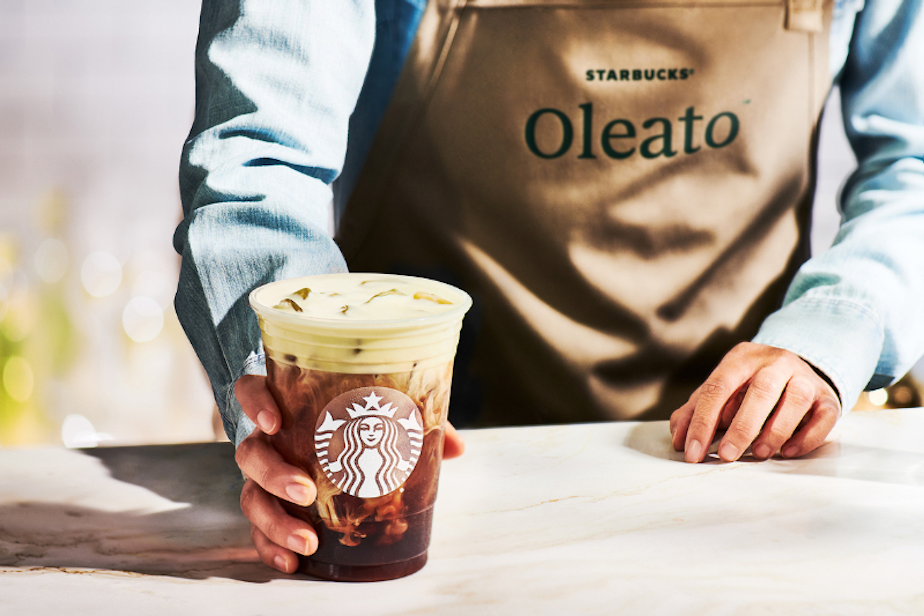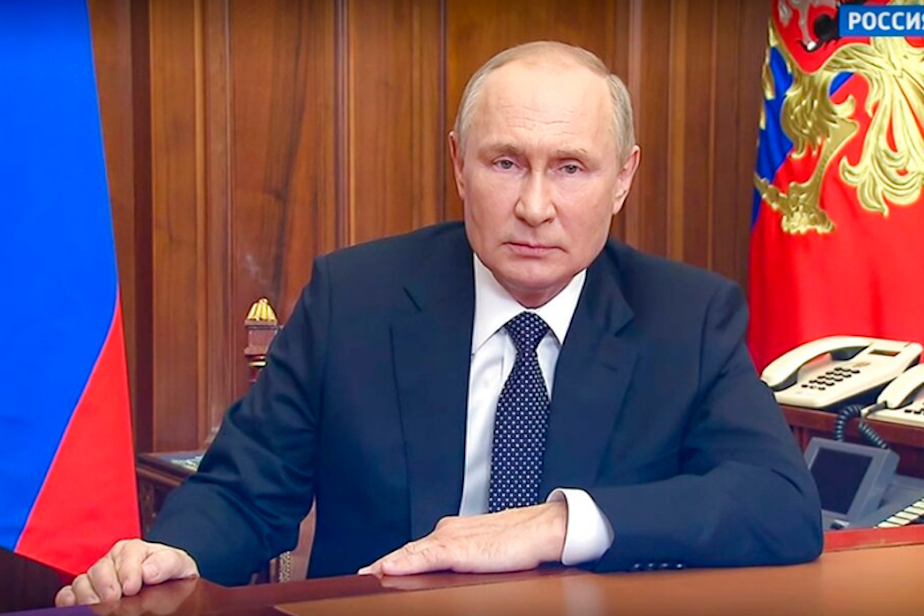Would you put olive oil in coffee?: Today So Far

- Starbucks' latest innovation is putting olive oil in coffee. Would you drink it?
- Days are getting longer, but it's still dark and cold these days. So try making your home a little more homey.
This post originally appeared in KUOW's Today So Far newsletter for February 22, 2023.
Starbucks wants to put olive oil in your coffee. Upon reading that, you likely had one of two responses: "Um, OK, interesting," or "Gross!"
Those were the two responses I got from the KUOW newsroom when I ran a quick, informal poll. Though some folks submitted and voted for a third option: "Distraction from recent bad press."
Today, I have blended a spoonful of olive oil into my coffee and I am drinking it as I write this newsletter. My initial reaction? Coconut oil is better. Also, butter is better. I generally put one of those in my coffee each morning. A lot of people do. Adding a form of fat (like cream) is not new to the coffee world.
Starbucks isn't simply adding olive oil to straight coffee, as I did. Its Oleato line is a handful of coffee drinks that include olive oil among their ingredients, like a latte, a cortado, or even an espresso martini. Oleato debuts today in Milan, Italy. It will brew up at U.S. locations this spring, then Japan, the UK, the Middle East, the moon, and beyond.
The way Starbucks makes it sound, Oleato is so new, it will change the coffee world as we know it. But as stated above, it's not entirely new (seriously, coconut oil is way better). But with any new product comes branding! As Starbucks puts it, CEO Howard Schultz had a couple inspirational trips to Italy. In 1983, he saw how Italians embraced coffee and wanted to bring that experience to the USA. We can't deny that Starbucks has since dramatically changed coffee culture across the world.
Sponsored
On a more recent trip to Italy, Schultz says he discovered another quirky cultural trait — taking a spoonful of olive oil each day. He tried it himself and quite liked it. Then, like a mad scientist, he poured that olive oil into his coffee and crafted a concoction that will change the world! Schultz then leaped from his bathtub and ran through the streets of Milan yelling, "Oleato! Oleato!" Wait, hold on ... I'm getting my world-changing legends mixed up.
Actually, it resulted in Starbucks' Oleato coffee drinks.
“I was absolutely stunned at the unique flavor and texture created when the Partanna extra virgin olive oil was infused into Starbucks coffee,” Schultz said in a statement announcing the new coffee line. “In both hot and cold coffee beverages, what it produced was an unexpected, velvety, buttery flavor that enhanced the coffee and lingers beautifully on the palate.”
At this point in my cup of coffee, I can confirm that olive oil does add a buttery flavor. I should point out, though, that there is another thing you can use to add a buttery flavor to coffee — butter.
I'm reminded of another coffee-branding legend, also from a Seattle company. Bulletproof Coffee says its roots go back to a trip its founder Dave Asprey took to the mountains of Tibet. After a tough trek through harsh conditions, Asprey was served a tea drink that had yak butter in it. And snap! He was invigorated. It gave him wings! (Wait, stop, that's actually Red Bull; it's hard to keep all this branding straight). Asprey returned to the United States to expand upon this revitalizing concoction and today we have Bulletproof Coffee, which contains butter and MCT oils (coconut oil).
Sponsored
If I were to brand my own morning coffee ritual, however, it probably wouldn't sound as romantic as these coffee giants. But if I tried...
"I was hiking the cold, rough terrain of Eastlake Avenue. The harsh winds off of Lake Union battered me at each step. My legs shook as I passed two men in a fist fight over which locally brewed IPA is best. Two nearby Seattleites affirm that they should hang out soon and that they'd be in touch, but we all knew it was a cold gesture and they would never call. A group of friends pointed fingers at each other, arguing over whether Columbia or North Face is better, before someone yelled over them about another outdoor brand that they heard of first, which could only be found at a small shop they also heard about first. Somehow, between the rain, traffic, cyclists yelling at traffic, and wind (did I mention the wind was harsh?), a voice broke through this urban cacophony. Was it a helpful passerby? Was it a spirit? Was it the podcast I had blaring through my earphones? 'Try putting coconut oil in your coffee,' this sage said. And I thought to myself, 'OK.' ... so ... I did and it was pretty good."
So yeah, I heard about it on a walk one day. If you had a branding tale for your morning coffee ritual, what would it be? Feel free to send it to me at dyer@kuow.org.
Starbucks' Oleato story didn't end with Schultz going, "Huh, we should put this in our coffee." The company tasked its beverage developer, Amy Dilger, with coming up with some options. Dilger became familiar with olive growers "who have nurtured these ancient olive trees in their rich Sicilian soil for four generations." Partanna extra virgin olive oil was chosen for the drinks. Starbucks took some time to develop products and some PR.
Aside from olive oil, around KUOW, editor Catharine Smith likes cashew milk in her coffee. Anchor Kim Malcolm likes half and half. Seattle Now's Trish Murphy adds a little milk. Editor Derek Wang said he loves olive oil and will have it with anything. Challenge accepted Derek, I will be bringing you a sundae with eggnog and cotton candy ice cream, topped with Sour Patch Kids and Peeps, drizzled with extra virgin olive oil.
Sponsored
We're still in the "big dark" time of year. Ya know, that time when, despite the days getting longer, it's still dark much of the time and it's still quite cold.
University of Washington Professor Milla Titova has a few thoughts on how to stay mentally healthy during this time of year. It all comes down to being "homey."
"It's kind of an interesting combination of psychological and physical elements," Titova told Seattle Now. "One of the things when people talk about when describing a place as 'homey' is that it feels lived in, or it feels like it's a place where you have memories of being with other people."
"The most uplifting part of the research that I've done is that it really shows it's not about what somebody else thinks your place should look like, it's not about having the biggest house, the most renovated house, the apartment with the best view, it's really about making it your own, and feeling comfortable in that space, and embracing the time you can have with other people in that space."
This advice is particularly important for a city like Seattle, where a considerable portion of residents are newcomers, passing through, or just moving around a lot. Even if you view your living space as temporary, take some time to make it feel like a homey space.
Sponsored
"When we move a lot, it's easy for us to think about our spaces as temporary ... I always do spend a lot of time trying to really make the place my own. I think it does provide this psychological comfort in a new space, especially when we are just new to the area and we don't know many people and we don't have social connections established as much," Titova said.
"During the time of the 'big dark' when it's dreary outside, it's much easier to invite people over ... and inviting people in your space and sharing it with them will be a great experience all around, for the hominess of your space, for your social connections, and for your happiness."
In other words, put some art on the wall, place that trinket from your travels out in the open, throw some olive oil in a cup of coffee, and invite a few folks over for a nice homey chat. Check out Seattle Now's full discussion about making your home more homey here.
AS SEEN ON KUOW

Sponsored
Hira Singh Bhullar, center, raises his fist in the air while leading a chant during a rally ahead of a Seattle City Council vote on a measure sponsored by Councilmember Kshama Sawant that would ban discrimination based on caste, on Tuesday, February 21, 2023, at Seattle City Hall. The bill was approved. Seattle is the first city in the nation to ban caste discrimination. (Megan Farmer / KUOW)
DID YOU KNOW?
On this day, Feb. 22, in 1932, the George Washington Memorial Bridge was officially opened. What is the George Washington Bridge, and where is it? Well, most folks call it the "Aurora Bridge," in Seattle, since Aurora Avenue passes over it, connecting Queen Anne and Fremont. When it was opened, it was a big deal. This was the final connection on the great Highway 99, a roadway that spanned the West Coast connecting Mexico with Canada. The highway's importance was downgraded a bit when freeways became a thing decades later. Another reason the bridge was a big deal, and the reason behind its name, is that it debuted on the 200th birthday of President George Washington. There were celebrations across the USA at the time.
To kick off the bridge-opening ceremony, President Herbert Hoover turned a key in Washington, DC, which sent a signal along a telegraph line. That signal reached Seattle and unfurled flags along the bridge. Gov. Roland Hartley was giving a speech at that moment and was cut off by the president's long-distance signal, which also prompted the start of a 21-gun salute, some sirens, a band to play the National Anthem, and fire boats to spray lake water into the air. Within a month of its opening, more than 11,000 cars were traveling across the bridge each day.
ALSO ON OUR MINDS

What happens now after Russia suspends the last nuclear arms treaty with the U.S.?
"We're not in a nuclear arms race today. But it's very concerning that we soon will be, because the bottom line is, this is the last nuclear treaty governing nuclear weapons of the United States and Russia that is in force. And obviously it's under incredible strain now, and potentially unraveling. It's set to expire in three years, and there's no dialogue going on between the U.S. and Russia about what would come after that."

